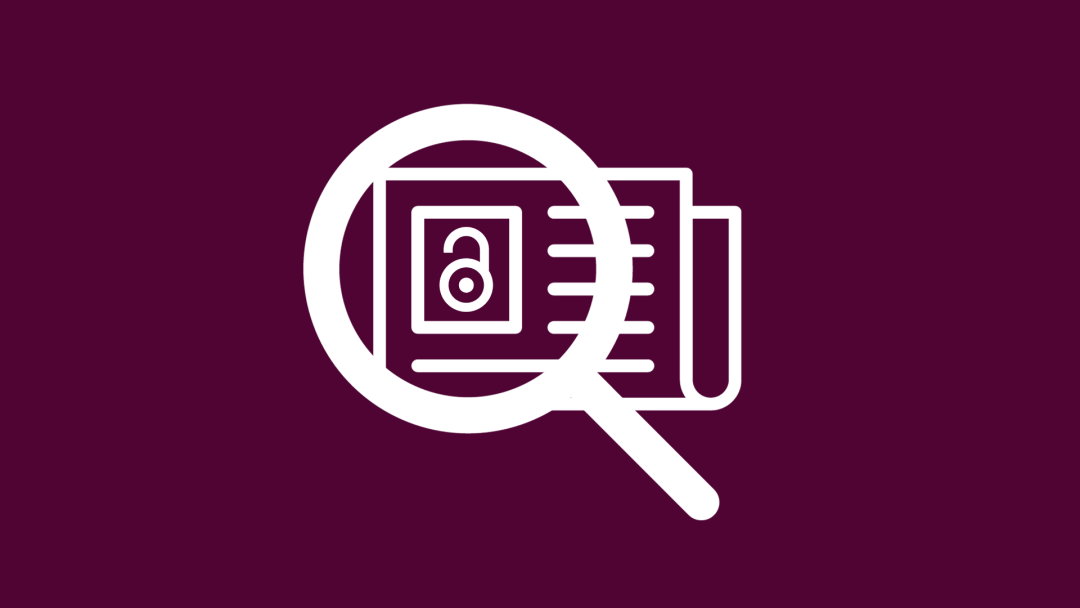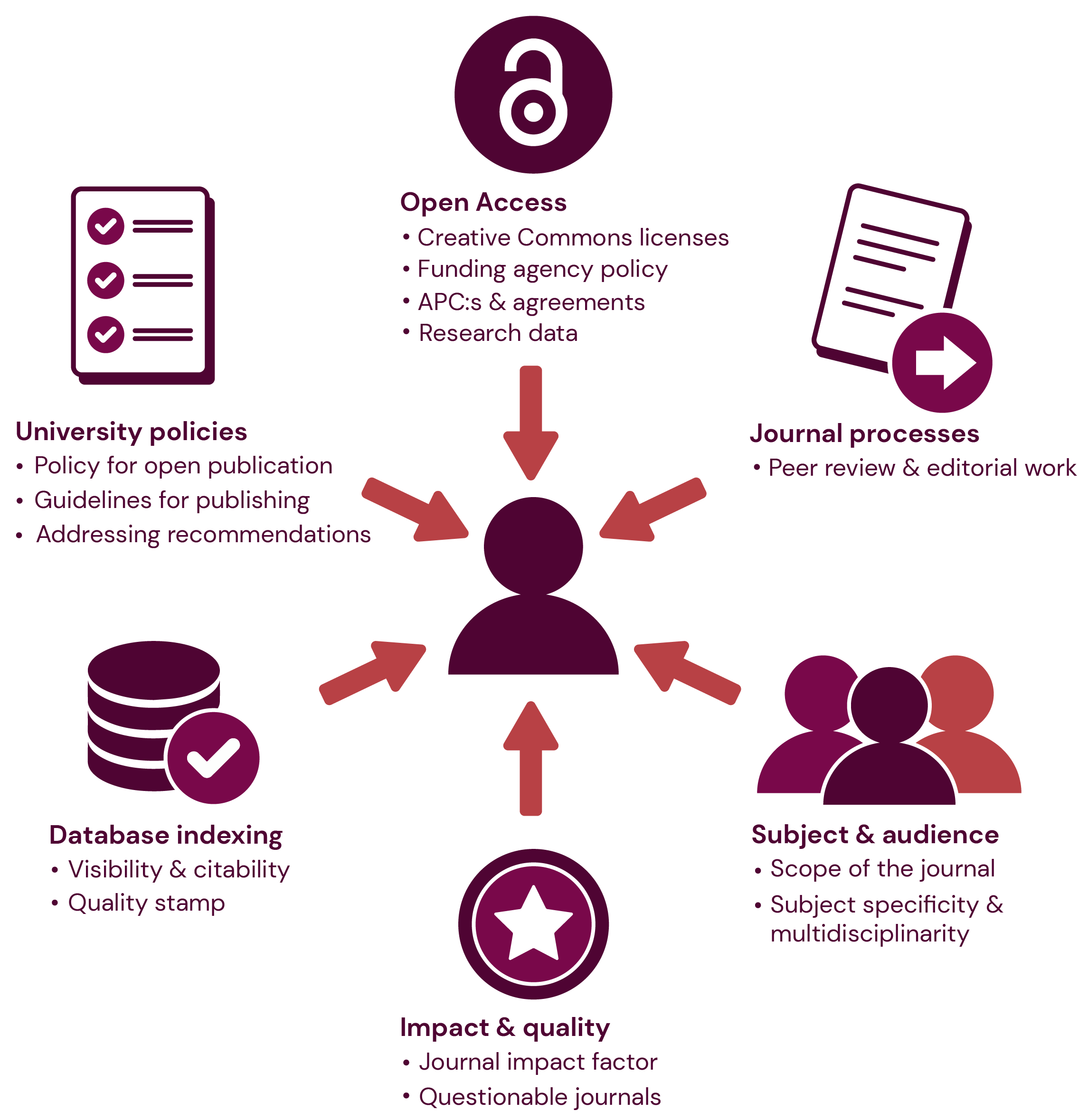Strategic publishing
Scientific communication often involves the publication of research results in journal articles. When publishing an article, there are a number of factors to consider and this page will guide you through them. These may include the impact of the intended journal in the relevant subject area or the databases in which the journal is indexed. Other important factors to consider are the university's publication policy and the Open Access requirements of research funders.
Open Access
Creative Commons licenses
When you publish open access, you allow others to read and disseminate your work, and often to adapt and reuse it. When you publish your article, you choose an open license, usually a Creative Commons license. This sets out what other people can and cannot do when using your work. You must always be credited as the author and you retain the copyright. Anyone who makes changes to your work must acknowledge it. There are different variants of the license, and KI advocates the most permissive license CC BY.
In addition to choosing a Creative Commons license, you also need to enter into a License to Publish (LTP) agreement with the journal. If you choose CC-BY-NC or CC-BY-NC-ND license, the LTP agreement often means that you contract away your economic rights to the article in a similar way as the copyright transfer agreement (CTA) does in traditional publishing for articles locked behind a paywall, not least with the larger commercial publishers.
Requirements from funders
More and more research funders are requiring that research results they have funded should be published open access, often immediately upon publication. You can read more about some of the major funders' requirements on the page on open access policies and demands.
Research funders may also require or recommend that you use a Creative Commons license, often the most permissive CC BY license. Read more on the page about research funders' requirements on CC licenses.
Publication fees and agreements
Many open access journals and subscription journals where it is possible to publish individual articles open access (hybrid journals) charge a publication fee or so-called Article Processing Charge (APC). KI has agreements with more than twenty publishers where the publication fee is prepaid for researchers at KI. The journals included in the agreements can be searched for in the Open Access/APC Checker Tool.

Open Access/APC Checker Tool
Search for a specific journal title to see if the journal is included in KI's open access agreements with prepaid publishing fees.
Research data
When choosing a journal, we recommend that you choose where to make available or publish research data associated with the paper/manuscript. The minimum level required at KI is metadata publishing, i.e. publishing a description of your data. Larger journal publishers have special information pages and recommendations on which guidelines apply in particular. In Europe and the USA, the financiers are increasingly demanding that in addition to publishing your article open access, you must also publish the research data that forms the basis of the research results. In line with KI's Policy for open access to research data KI works to ensure that the copyright for publication and reuse of research results is not exclusively transferred to commercial scientific publishers. Research data must not be made available via the publishers' paid services. Read more at Publish and share research data – an overview.
Journal processes
Peer review and editorial work
When you submit your manuscript to a journal, an editorial review of the manuscript is initiated, where the editor checks whether the manuscript meets technical and formal requirements, and whether the manuscript fits the journal's subject matter. If the manuscript passes the initial check, a peer review process - a quality review of the scientific content - is initiated. There are different forms of peer review. The reviewers' comments are then sent to the editor who decides whether to accept, revise or reject the manuscript. Most commonly, the manuscript needs to be revised based on the reviewers' comments before it is accepted for publication.
The chances that your manuscript will go through peer review and be accepted for publication also depends on other factors. Journals with a high reputation often select a lower percentage of submitted manuscripts for publication. By researching what kind of research a journal tends to publish, you can get an idea of the chances of your manuscript going through the process.
Keep in mind that the editorial and peer review process can take different amounts of time depending on the journal, ranging from a few weeks to a few months. At some journals, you can find information on how long it takes to get a first response and how long it usually takes for a manuscript to be accepted and finally published. If the journal does not specify this on its website, you can get a rough idea of the time by looking at the first page of recently published articles where the dates for received, accepted and finally published can be found. You can help facilitate the process by submitting a well-prepared manuscript that follows the journal's guidelines.
Subject and audience
Scope of the journal
A recommended strategy when publishing is to choose the journal where your research results will have the greatest impact. This is likely to be a journal that is "the best fit" in terms of subject or research area, and one that you know your colleagues in the field read. Other important target groups may be policy makers or health professionals.
Subject specificity and multidisciplinarity
To increase your chances of having your manuscript accepted, you should choose a journal with a focus that is as close to your research as possible. The focus can vary from subject-specific and highly specialized research areas to journals with a broad, interdisciplinary scope. Information about the journal's focus can usually be found under the heading "Aims and scope", "About this journal" or equivalent on the journal's website. Check that both the subject area and the type of research studies (review article, case study, clinical studies, etc.) published by the journal correspond to your research.
For tips on journals in your research field, you can use tools that match abstracts to relevant journals:
- Web of Science Manuscript Matcher (requires you to create an account).
- JANE – Journal/Author Name Estimator that maps to journals in PubMed.
- B!SON which matches your abstract and references to open access journals.
Impact and quality
Journal Impact Factors
Journal Impact Factor (JIF) is a measure of a journal's average citation rate per article in the Web of Science database but does not really say anything about the quality of individual articles. However, it is a measure used in much of medical science to rank journals and can help you choose a journal. Because citation patterns vary across disciplines, it is inappropriate to compare JIFs across disciplines and difficult to say what can be considered a high or low JIF. Journals in Web of Science are ranked and divided into quartiles within each subject area. The top quartile, Q1, includes the 25 percent of journals with the highest JIF.
Journal JIF is used as an indicator of research activity in Karolinska Institutet's central resource allocation. You can find information about the journals' JIF, subject affiliation, ranking and quartile in the sub-database Journal Citation Reports. More about citations, impact factors and other indicators can be found at the page on bibliometrics.
In addition to the Web of Science Journal Impact Factor, there are other journal indicators that are often displayed on journal websites, such as CiteScore, which is similar to JIF but is based on citations in the Scopus database (which KI does not have access to). There are also normalized journal indicators that enable comparisons between different subject areas: in Web of Science the indicator is called JCI (Journal Citation Indicator) and in Scopus SNIP (Source Normalized Impact per Paper).
Questionable journals
Questionable journals and publishers are phenomena that are unfortunately here to stay. These actors (often referred to as predators) often charge money in the form of publication fees but are deficient in terms of peer review and editorial work. These shortcomings in the journal's review processes may lead to substandard research slipping through and outright research fraud going undetected - in short, the scientific quality and integrity of the journal cannot be guaranteed.
Use the library's checklist on how to identify and avoid publishing in questionable journals.
Database indexing
Visibility and citability
The first thing you should make certain, to optimize the visibility of your article, is that the journal you intend to publish in is covered by the major bibliographic databases, such as MEDLINE, Web of Science, CINAHL or Psyclnfo. To find information on which databases contain which journals, look in the respective database in the first place. MEDLINE is the part of PubMed where articles are assigned subject headings (MeSH terms), which affect the visibility of your article. The journals covered by MEDLINE can be found in the NLM Catalog. Search for the journal and check that the field "Current Indexing Status" is "Currently indexed for MEDLINE".
Web of Science is divided into different sub-databases and in Journal Citation Reports you can see which journals are indexed and in which index(es) they are included. Karolinska Institutet's bibliometric database, which is used for resource allocation and many other analyses, uses citation data from Web of Science. Therefore, it is an advantage for you and your department that the journal you publish in is indexed. Information on which parts of Web of Science are included in Karolinska Institutet's bibliometric database can be found in our FAQ on bibliometrics.
Quality stamp
The fact that a journal is indexed in databases such as MEDLINE and Web of Science not only increases visibility but can also be seen as a quality stamp for the journal, as it has been reviewed before indexing. If you want to publish in a pure open access journal, you should also ensure that it is indexed in DOAJ (Directory of Open Access Journals).
Norway has a quality register for journals, often called the Norwegian list. Although the Norwegian list is not used at KI, it can be a support in your choice of journal. The journals in the register are divided into levels. Level 1 includes approved journals and level 2 consists of the highest ranked fifth of the publication volume within each subject area according to the Norwegian scientific community.
University policies
Policy for open publication
Karolinska Institutet has a policy for open access publishing. It concerns all researchers at, or affiliated to KI, who publish the results of research conducted at KI. The policy describes how KI's research publications should be published with regard to availability.
Read the Policy for open publication at Karolinska Institutet
Policy for open access to research data
Karolinska Institutet has a policy for open access to research data. It it applicable to all researchers at, or affiliated with, KI who produce data. The policy describes how KI's research data must be made available as open as possible.
Read the Policy for open access to research data
Adress recommendations
It is important that you state your address in accordance with KI's address recommendations. The consequence will otherwise be that these publications cannot be linked to KI/Region Stockholm in bibliometric analyses performed outside the organization. For example, they do not generate government funds or bibliometric points in various rankings.
Address recommendations from the Research Strategy Committee

Publication support
Contact us with questions regarding open access, KI's publishing agreements, bibliometrics, publishing in KI Open Archive and strategic publishing.
If you would like us to get back to you, please submit your contact information in the form below along with your feeback.

